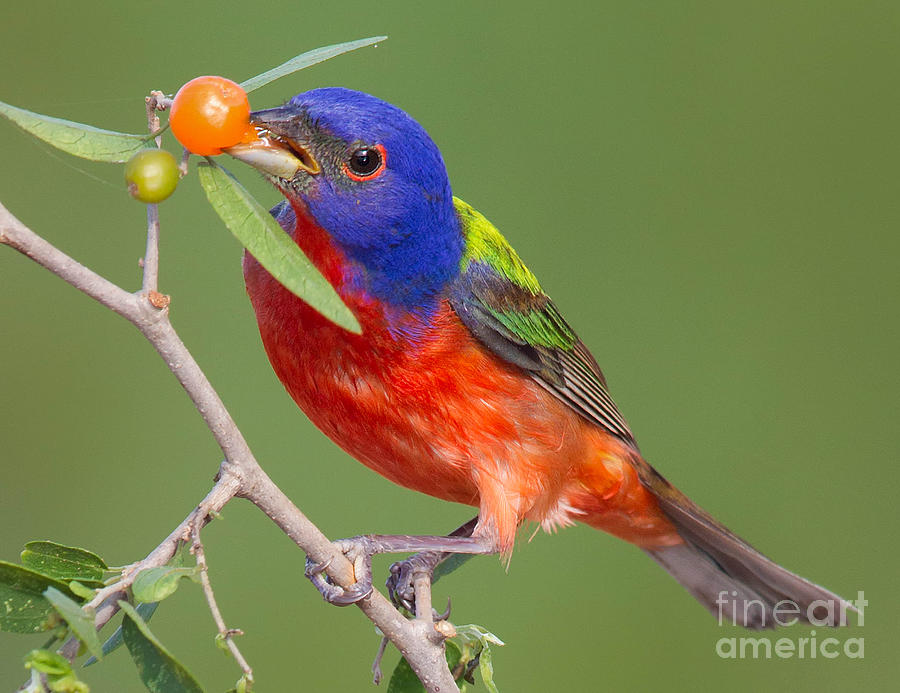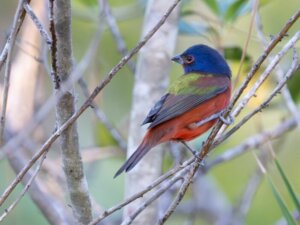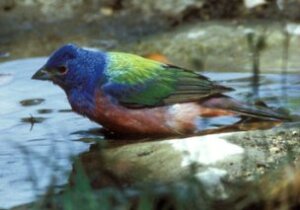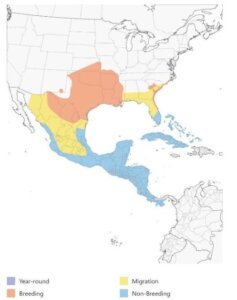What Eats a Painted Bunting? Unveiling Nature’s Predators
A Painted Bunting is a small, colorful bird. Many predators target it for food.
This beautiful bird, with its striking colors, faces many threats in the wild. Different animals, from birds of prey to small mammals, see the Painted Bunting as a tasty meal. Understanding these natural threats helps us appreciate the challenges this bird faces.
It also highlights the delicate balance of nature. By learning about what eats a Painted Bunting, we can better understand its survival tactics and the role it plays in its ecosystem. This knowledge can also inspire us to protect these vibrant birds and their habitats. Dive in to discover the predators of the Painted Bunting and their impacts on this stunning bird’s life.

Credit: redandthepeanut.blogspot.com
Introduction To Painted Buntings
The Painted Bunting is a small, colorful bird. It captures the hearts of bird watchers with its striking appearance. This bird is often called a “nonpareil,” meaning “unrivaled” or “without equal.”
The males are known for their bright and vivid colors. They have a mix of blue, green, yellow, and red feathers. Females and young birds have a more subtle green plumage. Understanding their characteristics and habitat can help us appreciate them more.
Colorful Characteristics
Male Painted Buntings are a sight to behold. Their heads are a bright blue. Their backs are green, and their undersides are red. This vibrant mix makes them stand out.
Females and young birds are not as bright. They have green feathers, which help them blend into the environment. This camouflage protects them from predators.
Habitat And Distribution
Painted Buntings prefer warm climates. They are often found in the southeastern United States. They also live in Mexico and Central America.
They like to stay in thickets, woodland edges, and brushy areas. These places provide good cover from predators. They also offer plenty of food sources.
During the breeding season, they move to shrubby areas and forests. In the winter, they migrate to more tropical climates. This migration ensures they have access to food year-round.
Natural Predators
The painted bunting, with its vibrant colors, is a sight to behold. But this beauty attracts predators. The bird’s survival depends on avoiding these threats. Let’s explore the natural predators of the painted bunting.
Birds Of Prey
Birds of prey are one of the main threats. Hawks and owls are skilled hunters. They have keen eyesight and can spot a painted bunting from afar. During the day, hawks patrol the skies. At night, owls take over the hunt.
These predators are relentless. They use their sharp talons to capture their prey. The painted bunting must stay alert. A moment of inattention can be fatal.
Mammalian Threats
Mammals also pose a significant risk. Cats, both wild and domestic, are agile hunters. They can climb trees and stalk their prey silently. Raccoons and squirrels often raid nests. They eat the eggs and the young birds.
These mammals are opportunistic. They take advantage of unguarded nests. The painted bunting’s beautiful colors are no defense against these threats.
In the wild, survival is a constant challenge. The painted bunting must navigate these dangers daily. Understanding these threats helps us appreciate the bird’s resilience.
Avian Predators
Painted Buntings are small, colorful birds. They are preyed upon by many avian predators. These birds of prey pose a significant threat to Painted Buntings. Understanding these predators helps in the conservation of these beautiful birds.
Hawks And Falcons
Hawks and falcons are skilled hunters. They have keen eyesight and swift flight. They can spot a Painted Bunting from far away. Once they see their prey, they dive at high speeds to catch it. The Painted Bunting’s bright colors make it an easy target. These predators often hunt during the day.
Owls And Other Night Hunters
Owls hunt Painted Buntings at night. These nocturnal birds have excellent night vision. They can see in the dark and catch unsuspecting buntings. Owls also have silent flight, which helps them sneak up on their prey. Other night hunters, like nightjars, may also pose a threat.
Mammalian Predators
Painted Buntings, with their vibrant colors, are a target for many predators. Among the top threats are mammalian predators. These creatures use their keen senses to hunt and capture these beautiful birds. Here, we explore the main mammalian predators that pose a danger to Painted Buntings.
Domestic Cats
Domestic cats are a significant threat to Painted Buntings. These agile hunters have sharp claws and teeth, making them effective predators. Cats often stalk their prey silently and pounce with precision. Even well-fed domestic cats still hunt birds for sport.
Raccoons And Squirrels
Raccoons and squirrels also pose a threat to Painted Buntings. Raccoons are nocturnal and have a keen sense of smell. They can easily locate bird nests and eat the eggs or young birds. Squirrels, while primarily herbivorous, sometimes raid nests for eggs and nestlings.
| Predator | Hunting Method | Impact on Painted Buntings |
|---|---|---|
| Domestic Cats | Stalking and Pouncing | High |
| Raccoons | Foraging at Night | Moderate |
| Squirrels | Nest Raiding | Low |
Human Impact
The Painted Bunting is a beautiful bird. Sadly, human activities threaten its survival. These activities affect their habitats and population numbers.
Habitat Destruction
Humans clear forests and fields for development. This destroys the Painted Bunting’s home. Without these habitats, they struggle to find food and shelter. Farming and urban expansion take away the natural landscapes they need. Conservation efforts are crucial to protect these areas.
Illegal Pet Trade
The Painted Bunting’s bright colors make it desirable. People capture them illegally to sell as pets. This reduces their numbers in the wild. Capturing these birds disrupts their breeding and feeding patterns. Educating people about the consequences of this trade is essential.

Credit: www.blog.catandturtle.net
Conservation Efforts
The beautiful Painted Bunting faces many threats. These include habitat loss, predation, and climate change. Conservation efforts are crucial to protect this species. These efforts focus on habitat protection, community involvement, and creating awareness. Below, we discuss some key initiatives.
Protected Areas
Creating and maintaining protected areas is vital. These areas provide safe habitats for Painted Buntings. They help in reducing habitat loss. National parks and wildlife sanctuaries play a key role. They ensure the bird has a safe place to live and breed.
- National Parks: These areas protect large habitats.
- Wildlife Sanctuaries: Smaller, but equally important for conservation.
- Nature Reserves: Often managed by local communities.
Protected areas also help in research. Scientists can study Painted Buntings in their natural habitat. This helps in understanding their needs and behaviors. Such knowledge is crucial for effective conservation strategies.
Community Involvement
Community involvement is essential for conservation success. Local people can help in many ways. They can participate in habitat restoration projects. They can also spread awareness about the importance of Painted Buntings.
Educational programs in schools and communities make a big difference. They teach people about the birds and their habitats. This encourages people to protect the environment.
Here are some ways communities get involved:
- Habitat Restoration: Planting native trees and shrubs.
- Bird Watching Groups: Monitoring bird populations.
- Educational Programs: Teaching about conservation.
Community efforts have a lasting impact. They ensure that Painted Buntings have a future. By working together, we can protect this beautiful bird for generations to come.

Credit: fineartamerica.com
Frequently Asked Questions
What Animals Prey On Painted Buntings?
Predators of Painted Buntings include snakes, raccoons, and domestic cats. These animals often target eggs and fledglings. Birds of prey like hawks also hunt adult Painted Buntings.
Do Hawks Eat Painted Buntings?
Yes, hawks are known to prey on Painted Buntings. They can catch both adult birds and young ones. Hawks are skilled hunters and pose a significant threat.
Are Painted Bunting Nests Targeted By Predators?
Yes, Painted Bunting nests are often targeted by predators. Snakes, raccoons, and even other birds may raid nests. They aim to eat eggs and young chicks.
How Do Painted Buntings Protect Themselves?
Painted Buntings use camouflage and dense foliage to hide from predators. They also remain quiet and still when danger is near. This behavior helps them avoid detection.
Conclusion
Painted Buntings face threats from various predators. Hawks, snakes, and domestic cats hunt them. Protecting their habitats helps reduce these risks. Keep your pets indoors and support local conservation efforts. Learning more about these beautiful birds can inspire actions to protect them.
Small steps can make a big difference. Let’s work together to ensure their survival. Your efforts can help preserve these colorful birds for future generations.
Hello Dear, I'm Poli Kolymnia, owner of many birds (including budgies).
With a deep passion for these feathered companions, I'm here to share my expertise and extensive knowledge on birds care.
My articles cover essential topics like diet, housing, care, and health, providing practical tips to help you create a happy and thriving environment for your birds.



